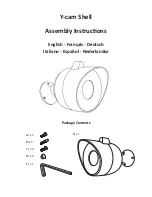
1
Getting Started
This chapter describes:
Preparing to Install Your iCVR
Configuring Your PC for DHCP
Discovering Your IP Address Through DHCP
Configuring Port Forwarding
Aiming the Camera for Best Performance
Preparing to Install Your iCVR
Before installing your iCVR verify that you have:
Network connection
: A Cat5 (or greater) network drop with connection
back to the network switch or router.
Mounting hardware (enclosure, brackets, etc)
: For exterior
applications, the iCVR must be installed in an IP66 (or greater) rated
housing.
IP addressing scheme
: By default the iCVR is set to acquire an address
via DHCP. If you’re using a static IP assignment, the IP address subnet
and gateway information should be determined before installation time.
Power connection
: PoE is the preferred method for powering the iCVR.
12VDC or 24VAC power options are also available. Power consumption is
typically 8W, maximum 12.9W. Ensure an adequate cable and power
source are available at the installation point.
Lens selection:
Lenses should be selected and adjusted so that the
objects to be detected are visible for at least 4-5 seconds, and are taller
than 5% of the height of the field of view.
Note:
Lens selection is not required for the dome camera.
Router port-forwarding setup:
If a remote site will be connecting to the
iCVR to receive alarms or manage settings, then appropriate ports need
to be opened in the exterior firewall (443, 554, 5401, 20022).
PC or Laptop:
With the View software installed to verify iCVR setup and
operation.
Scene lighting:
In most situations some external lighting (visible or IR)
will be required to capture sufficient object detail for recognition.
Содержание ICVR
Страница 1: ...VideoIQ User Guide Release 3 0 ...
Страница 5: ......
Страница 120: ...VideoIQ User Guide 110 The Exported Items Viewer Displays Double click on a row to view the video in the Video Player ...
Страница 121: ...Exporting 111 3 If you don t have the plug in to play the video you can download it from the VideoIQ support site ...












































